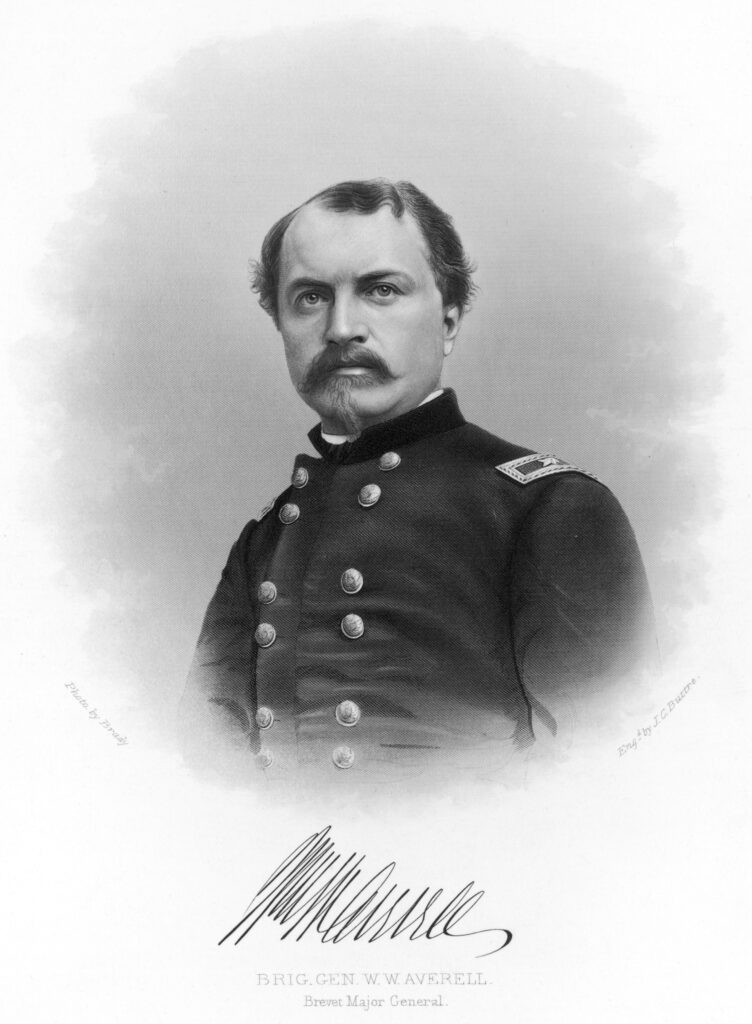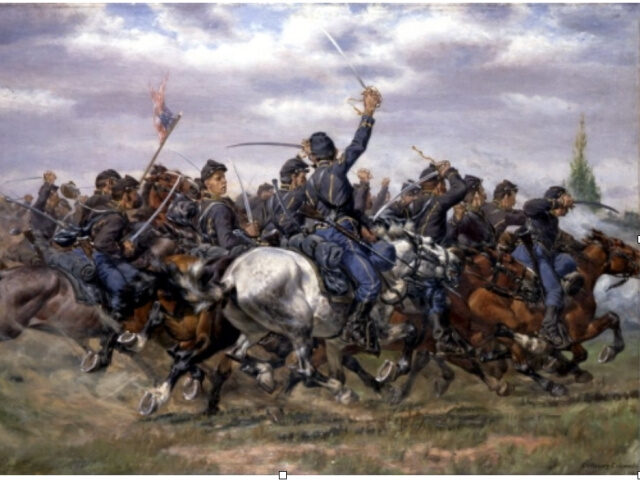Countless times in American history, commanders have promised to have the boys home by Christmas. In December 1863, in desperate need to relieve Knoxville, Tennessee, from the pressure of the surrounding Confederate troops, the Union high command planned a daring raid.
Union scouts in Confederate uniforms, Lincoln’s Special Forces, would lead General William Averell’s troops behind enemy lines to cut the Confederate’s crucial southern supply line—the Virginia and Tennessee Railroad. The hope was to have the men home by Christmas.
In early December, the elite Lincoln’s Special Forces wearing Confederate gray and armed with repeating rifles mounted on their fastest horses to spearhead the march. Bone-chilling wind and sleet pelted eighteen-year-old Archibald Rowand and his partner for several hours as they rode toward a creek in the middle of nowhere in West Virginia, conducting reconnaissance and locating any enemy troops that could impede the unfolding Federal raid. Several miles before the creek, lead tore into Rowand’s horse and partner, killing them both. Rowand escaped on foot back to the main force and made a full report of what transpired to one of Averell’s staff officers.
The precious tactical intelligence furnished by the Scouts became the lifeblood on which crucial decisions flowed. When the accuracy of Rowand’s information was initially brought into question by a mix-up in communication, he cooly told the general, “The best evidence is you will find my dead horse there and find my partner’s body.” Once the intelligence was confirmed, Rowand only reported directly to the general in command for the rest of the war.
Despite the ambush, the Confederates still did not know the full extent or whereabouts of Averell’s hundreds-of-men-strong raiding force, and they continued probing deeper into Southern territory. But Averell’s plan started to unravel. The muddy mountain trails and swollen streams proved impassable for the supply train, forcing it to be abandoned. Concerning reports of other Union forces overwhelmed by Confederate troops and fleeing for their lives began to flow in. General Scammon, who was supposed to hold Lewisburg and keep the Confederates distracted and pinned down, had instead abandoned the town. Now, Southern troops could concentrate on the real threat: Averell’s raiders.

Portrait of Union General William Woods Averell, (1832-1900), whose battles include Antietam, 1861, and Fredricksburg, 1862 during the Civil War. Original Artwork: Engraved by J C Buttre, after photograph by Brady. (Photo by Hulton Archive/Getty Images)
The dashing New Yorker nonetheless ordered his men to mount up and move forward through the rough terrain in the treacherous winter weather. During their journey through the sparsely inhabited, dense wilderness, the men suddenly saw signs of civilization: a light from a cabin window. A Union soldier entered and found a couple and several children. After the soldier identified himself as a Yankee, the man asked, “Stranger, whar is your horns?” The woman responded, “Didn’t I tell ye they’re human critters like the rest of us.” The officer asked who told him Yankees had horns. “The men that came round making war speeches and recruiting for the Rebel army!”
Advancing over the mountains, the Scouts also stumbled upon a wedding party. They surrounded the revelers, capturing all, including the bride and groom—a Confederate soldier. After inhaling the wedding feast, leaving only a small bottle of vinegar behind on the table, the force marched on, taking their prisoners of war with them. When she realized they were taking her groom, the bride also insisted on going, marching side-by-side with the men in the cold, rain, and mud until they reached Salem, VA.
Along the way, in their butternut uniforms, the Jessie Scouts captured enemy pickets and a Confederate dispatch rider, preventing priceless information from being delivered and delaying the Confederates’ knowledge of the actual whereabouts of Averell’s force. Eventually, however, the Confederates knew where he was headed: to the Virginia and Tennessee Railroad depot in Salem, VA.
Lincoln’s Special Forces brought Confederate Scouts as captives back to Averell, from which they learned that a train loaded with Confederate troops from Lynchburg was approaching Salem. The Union commander ordered 350 men and two three-inch guns to meet the threat. Riding at breakneck speed, advance troops cut the telegraph wires, tore up track near the Salem depot, and set up guns to ambush the Confederate reinforcements. When a shot from the guns pierced the train, the engineer threw the locomotive in reverse. The bulk of Averell’s forces now entered the town and went to work destroying the track and the Confederate infrastructure. For miles up and down the rail line, they torched bridges and destroyed as many tracks as possible. They removed the rails from the ties, created massive bonfires, and then placed the metal rails on top, attempting to twist them once heated.
With the Confederates fully alert, well over a hundred miles behind enemy lines, and six Confederate commands attempting to block their retreat north, Lincoln’s Special Forces would help Averell pull off a near-miraculous escape. They found and hauled in a local doctor who knew the area from his rounds through the countryside and presented him to the general.
After appeals to the doctor’s pocketbook and the security of his family failed, Averell offered the man five minutes to choose between life and death. With the doctor’s help, the Scouts found an obscure trail that allowed the command to march parallel to Mudwall Jackson’s troops without being detected as they headed toward the bridges at Covington, Virginia, that spanned the swollen, raging Jackson River.
In desperate attempts to throw off his pursuers, Averell kept the campfires lit after they left and sent a detachment of men in another direction to deceive his enemy. The Confederates set traps on the bridges in the area, the crucial chokepoints enabling life-and-death egress over the swollen rivers.
Finally reaching the Island Ford Bridge at Covington, the butternut-clad Scouts found it not only miraculously still intact but also intercepted a single Rebel rider approaching the bridge who unsuspectingly told them, “I am going to Colonel Jackson with a dispatch from General Jones.” The intercepted dispatch contained the orders to destroy the bridge immediately. Upon reading it, Averell ordered his men to descend on the small party of Confederates preparing to torch the bridge. Their horses crowded to race over the wooden structure to the safety of the solid ground on the other side of the furious stream. The baggage train carrying wounded men and prisoners of war, including the Confederate groom captured days earlier, along with their rear guard, the 14th Pennsylvania Cavalry Regiment, lagged several miles behind. Knowing “not less than 12,000 men were maneuvered to effect my capture,” Averell made the heart-wrenching decision to sacrifice his rear guard and torched the bridge himself to prevent the Confederates from pursuing him.
I explore this story more in my forthcoming book The Unvanquished: The Untold Story of Lincoln’s Special Forces, the Manhunt for Mosby’s Rangers, and the Shadow War That Forged America’s Special Operations.
When the 14th Pennsylvania and other members of the baggage train realized their situation, they burned their wagons, including their rations and other supplies, to lighten their burden and feverishly searched for another place to ford the ice-filled swollen Jackson River. While they searched, a rider from Mudwall Jackson’s force under a white flag of truce approached the men and presented them with an opportunity to surrender.
Southern and Northern reports differ on how the Yankees escaped, but confusion bought the Pennsylvanians precious time to find a fording place. The first man and his horse made it across and received a cheer from the men still on the bank. The rest of the force followed. Several men were swept away by the current, including Confederate groom. Separated from Averell, the 14th Pennsylvania Cavalry and other stragglers made it to yet another bridge burned by Averell and thus had to ford another treacherous river. But without Confederate troops directly on their heels, the men crossed safely. Once the last stragglers in the 14th crossed at Covington, Confederate commands gave up the chase.
So on Christmas Day, in terrible shape, barefoot, suffering from frozen limbs and feet, starving, without sleep, and under constant duress from the threat of attack, the men made the long, exhausting march back to Beverly, West Virginia. As a belated Christmas present, when they arrived on December 26, having completed a 400-mile march in twenty days mostly in hostile Confederate territory with their uniforms reduced to rags, they astonishingly would be presented with the expectation to replace their worn-out gear using personal funds. But at Averell’s request, the War Department charitably, at least in the eyes of the government, acquiesced and made an exception to their miserly policy.
Patrick K. O’Donnell is a bestselling, critically-acclaimed military historian and an expert on elite units. He is the author of thirteen books, including his forthcoming book on the Civil War The Unvanquished: The Untold Story of Lincoln’s Special Forces, the Manhunt for Mosby’s Rangers, and the Shadow War That Forged America’s Special Operations releasing in May, The Indispensables, Beyond Valor, First SEALs, and The Unknowns. O’Donnell served as a combat historian in a Marine rifle platoon during the Battle of Fallujah and often speaks on espionage, special operations, and counterinsurgency. He has provided historical consulting for DreamWorks’ award-winning miniseries Band of Brothers and documentaries produced by the BBC, the History Channel, and Discovery. PatrickKODonnell.com @combathistorian

COMMENTS
Please let us know if you're having issues with commenting.